The pushup has been a common indicator of upper body strength for a long time. The term itself is more than a century old. They are standard in many military training programs, fitness assessments, workout programs, and fitness challenges. In fact, if you asked most people how many pushups they could do, they would immediately have a general Idea if they are capable or incapable of performing the movement at all. If you can perform multiple pushups with good form, there is a good chance you have a base of strength that is more than the average person. Performing a good pushup requires a significant amount of core strength, hip control, shoulder stability, arm strength, and chest strength. Although the pushup itself isn’t an ominous looking movement like a power snatch or barbell thruster, it is a very technical movement and can be difficult to learn for those who desire to become proficient at performing high volumes.
How to do pushups
1. High Plank Hold
The first thing you must realize when starting to learn how to do pushups, is that the movement starts with your ability to how yourself in a high plank position. As previously stated, the benefits of pushups go beyond a strong chest. You must develop a strong core and good hip and shoulder stability. To do this, you must become good at holding a high plank position. This is the starting and finishing point for every pushup rep you perform. When performing the high plank hold, your glutes should be engaged, shoulders squeezed, and core tight. Once you can hold this position for a minimum of 1 minute in good position without getting too tired, you have developed strength to start adding the pushup motion.
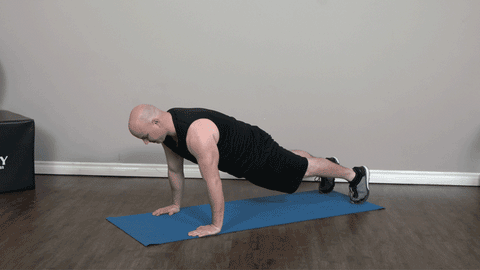
2. Pushup Negatives
After mastering the high plank hold, you must start learning how to do pushup negatives. Pushup negatives are performed by starting in the high plank position and lowering yourself down to the floor in a slow and controlled manner. Do not try to press yourself back up to the high plank position. Simply return to the high plank position and perform the next rep. Doing this motion will introduce the muscles of your arms, chest, and shoulders to the demands required to perform good pushups with a stable body position without requiring them generate the strength needed to push your body back up. Perform 2-3 sets of 5 to 10 reps of the pushup negatives as part of your regular pushup workout routine.
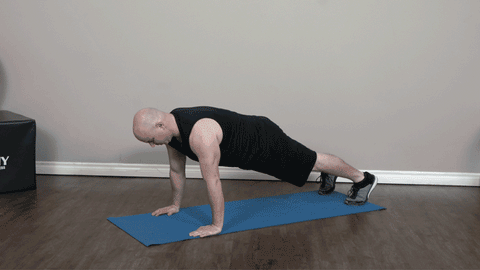
3. Elevated Pushups
After building the strength to hold a high plank position and perform multiple sets of pushup negatives, you should be ready to start performing the pushup movement on an elevated surface. Performing a pushup workout in this way reduces the amount of strength need to perform the pushup movement. Start by choosing a surface to place your hands that is about as high as your hips. As you get stronger, you can lower the level of your pushups to a surface that is about the height of your knees. As soon as you can perform multiple sets of 10+ pushups at these different heights, you will be ready to start moving to the floor for some real pushups.

4. Partial Range Pushups
Just like the elevated pushups, you must start with a progression before you start trying to bring your whole body down to the ground and then back up to perform a full pushup. To do this, you can perform partial range of motion pushups. This means that you will be performing pushup to a point that is not quite all the way down to the floor. You can choose to use any object to mark a comfortable depth to perform. The good news is that once you can perform pushups to a depth of about 3 inches off the ground, you are putting your body is an optimal position to perform quality pushups. After you are confident performing multiple sets of 5+ reps of pushups to a certain point off the ground, you are ready to start attempting full pushups to the floor.
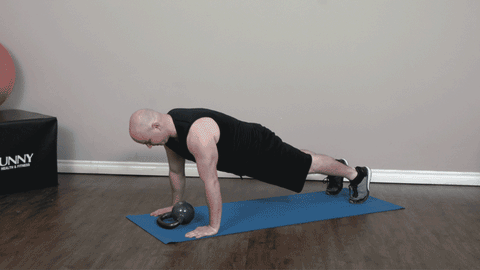
5. Full Range Pushups
Once you are ready to start full range pushups, it is important to know if your body is healthy enough to withstand the joint stress that could potentially lead to injury when performing a high volume of chest to floor pushups. If you have a history of shoulder joint or elbow joint issues, you should consult with your doctor to make sure pushup workouts are safe for you to perform. Start by performing a few good pushups with good form. Give you body a couple minutes to rest and then perform another set of the same amount. Once you are comfortable performing multiple 2-3 sets of a low rep amount, start trying to increase the number of reps you perform on the first set. For example, if performing 3 sets of 3 full pushups becomes easy, add one or two pushups to the first set and try to complete the same amount of sets with the new rep amount. You should be able to do this for a few weeks and see good improvement with your pushup volume. After a few weeks of your full pushup workouts, test yourself to see how many pushups you can do in a row.
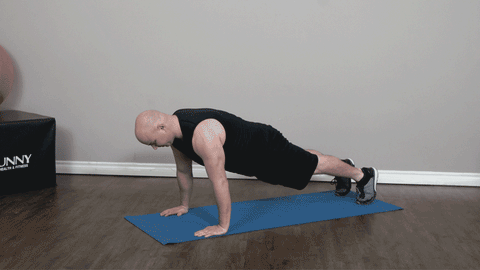
Push Up Coaching Points
- Hands should be placed slightly wider than shoulder width apart
- Your feet should be together or about hip width apart
- Your body should in a neutral position, with a straight line form your heels to your head.
- Breath in on the way down and out on the way up.
- DO NOT stick point your elbows out to the side.
- DO NOT arch your lower back.
Other Pushup Variations
- Wall Pushups (Easy)
- BOSU Pushups (Medium)
- Decline Pushups (Hard)
- Plyo Pushups (Very Hard)















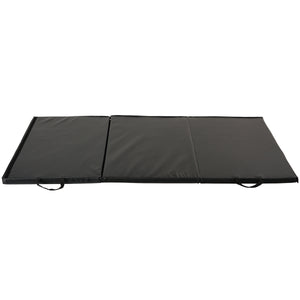








Add Your Name & Email
Please enter your name and email to continue.We won’t display your email publicly.